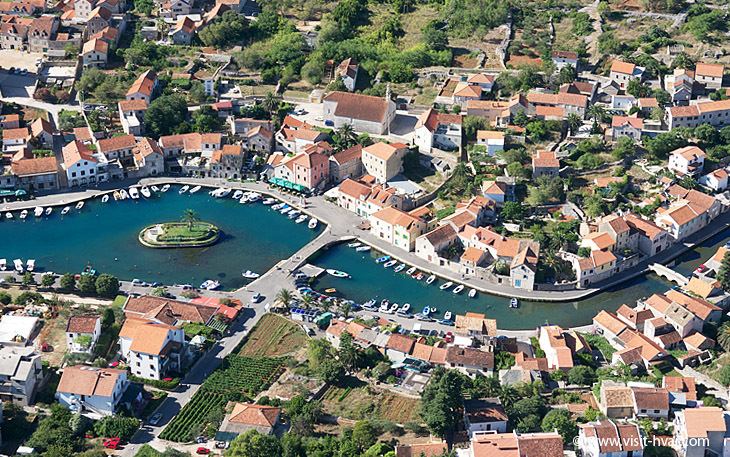Elevation 0 m (0 ft) Postal code 21463 Vrboska Local time Wednesday 8:46 AM | Time zone CET (UTC+1) Area code(s) +385 (0)21 Population 526 (2001) | |
 | ||
Weather 13°C, Wind N at 3 km/h, 78% Humidity | ||
Vrboska is a settlement on the north coast of the island of Hvar in Dalmatia, Croatia, in the Municipality of Jelsa. Founded in the 15th century as a fishing harbour, Vrboska is best known for the fortress Church of Sv. Marija (St Mary), built as a refuge for its inhabitants during the 16th century. Vrboska has a population of 526 at the 2001 census.
Contents
Map of Vrboska, Croatia
Geographical
Settlement on the northern coast of the island of Hvar in a deep narrow bay surrounded by pine forest, vineyards, and olive groves. Vrboska lies on the north-eastern side of the UNESCO protected world heritage site Stari Grad Plain.
Name
Vrboska, (local dialect Varboska) The name is probably derived from Vrbanj, the inland village whose inhabitants originally used the sheltered inlet as a fishing port. Another theory is that it comes from the Latin verboscam, meaning forested.
History
Founded in the Middle Ages, the oldest building is the church of St Peter, which was built before the 14th century between the boundaries of Pitve and Vrbanj. In the immediate vicinity, on the Stari Grad Plain, is the ancient Villa Rustica.
Matija Ivanić, the populist leader of the Hvar Rebellion of 1510-1514, had a house in Vrboska. The Venetian troops attacked the town in 1510, causing extensive damage. In 1571, the town was again attacked, this time by the Turks, under Uluz Ali. Soon afterwards, in 1575, the church of St Mary was fortified, to become a church-fortress, a unique sight in the islands.
The place developed as a fishing community, trading and growing in prosperity. At the beginning of the 20th century, Vrboska had a sardine factory, wooden boat-building industry, a hotel, fishing trade association, and regular boat connections with Split and the neighbouring island of Brač. There was a community hall, library and health clinic.
Economy
Vrboska today is a tourist destination with a popular yachting marina.
Culture
The church of St. Mary of Mercy was re-built in the shape of a fortress around 1575 following the Turkish attack on the older church from 1465. The parish church of St. Lovrinac was built in 1571, and restored in the 17th century. The main altar of St. Lovrinac has a Paola Veronesca, and work of John Rendic. There are also paintings by the Venetian Masters: Tizian, Cagaliarija, Bassano, Scuria, Cellinia and others. The church of St. Peter, mentioned in 1331, was a border point between the territory of neighbouring villages Pitve and Vrbanj, even before the founding of Vrboska. Restored in 1469 it is considered one of the oldest religious buildings on the island. The townsfolk of Vrboska are proud also of their Fishing Museum.
The patron saint of Vrboska is St Lovrinac.
